Born in Florence, he probably studied originally under Byzantine-style artists, but he "rose above it." His painting style is credited with defying the usual flat medieval style and developing more realistic proportions with lifelike shading. Giorgio Vasari centuries later told the tale that it was Cimabue who came across a young Giotto sketching sheep and, so amazed at his realistic drawing, invited him (with Giotto's father's permission) to come to Cimabue's studio.
Vasari, supposedly quoting a contemporary of Cimabue, says "Cimabue of Florence was a painter who lived during the author's own time, a nobler man than anyone knew but he was as a result so haughty and proud that if someone pointed out to him any mistake or defect in his work, or if he had noted any himself... he would immediately destroy the work, no matter how precious it might be."
In a case of the student exceeding the master, Dante mentions (not places, although Cimabue was dead by the time Dante was writing the Commedia) Cimabue in the Purgatorio as an example of fleeting fame while discussing those who suffer from excessive pride: “Cimabue thought himself the master of painters; Giotto took from him the glory and relegated him to oblivion.”
To be fair, however, Cimabue was not relegated to oblivion. We are aware of several works by Cimabue (more than those of which we can be certain were made by Giotto). For instance, the illustration above is a small detail (Judas betraying Christ) from a fresco in the Church of San Francesco (St. Francis) in Assisi, commissioned by Pope Nicholas IV (the first Franciscan who became pope).
Cimabue is also credited with the round stained glass window of the choir of Siena Cathedral, as well as a painted Madonna and Child (now in the Louvre), and the fresco Christ Enthroned between the Virgin and St. John the Evangelist in Pisa Cathedral.
One interpretation of Cimabue's impact on art is to call him the first great artist of the Italian Porto-Renaissance. I suppose Proto-Renaissance could use some explanation, which I'll provide tomorrow.



.png)










